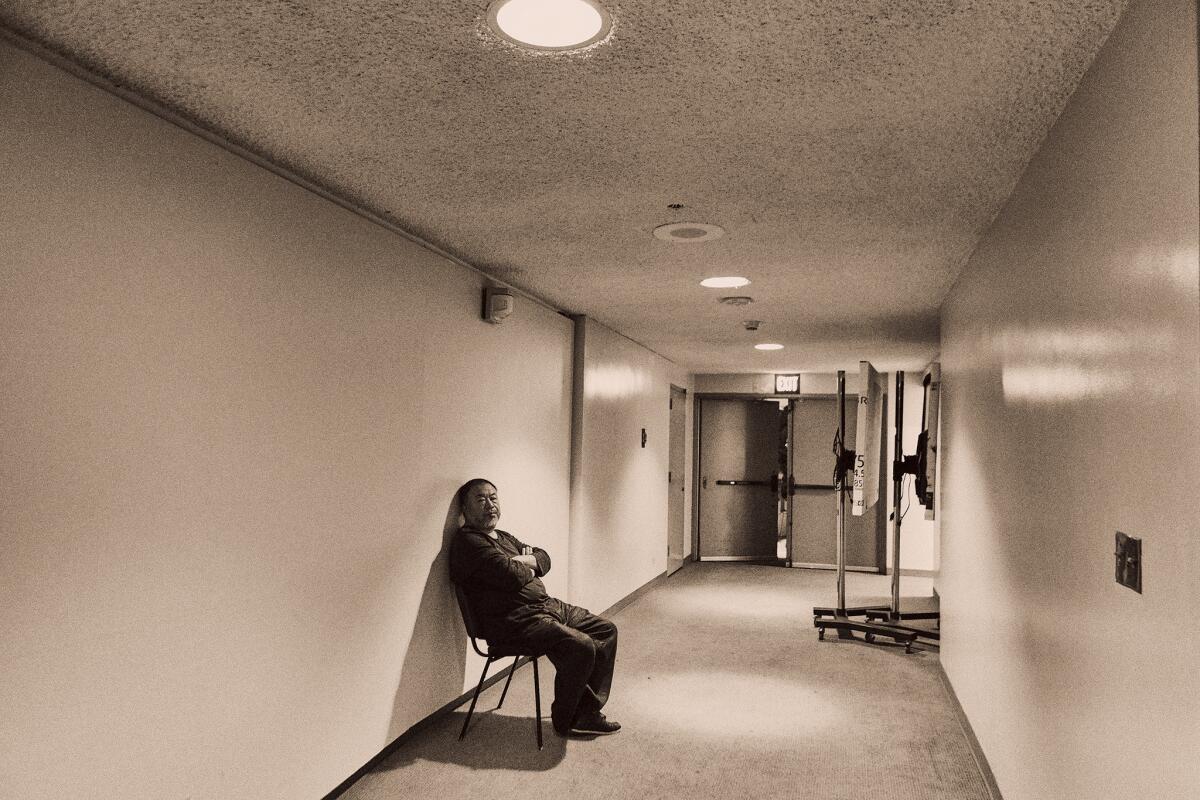Ai Weiwei storms L.A. with a trio of powerful shows
Itâs just past lunchtime on a Wednesday in late September and Ai Weiwei is in the middle of a coughing fit. âIâm not sick, just over-sensitive about the environment, this fixed office, the air, you know,â says Ai. Though his bearded visage and raised middle finger have become symbols of anti-establishment sentiment the world over â replacing Che Guevara as the du jour icon of rebel chic â despite the stagnant air, the Chinese artist, architect, filmmaker, poet, activist and refugee is nothing if not inviting, humble and devilishly funny.
Dressed in a California-casual uniform of well-trod Toms Shoes, a loose-fitting pair of black drawstring trousers and a blousy blue T-shirt, heâs seated at the head of a conference table in a fishbowl office facing a circular stained-glass window. Once obstructed from this second-floor office, the window was previously utilized as a source of exterior illumination by the Scottish Rite Masonic order who originally inhabited this Millard Sheets-designed theater and meeting hall, now the Marciano Art Foundation. Though itâs a banner fall day in Los Angeles, Ai has been held prisoner by the media circus inside this private museum; his only view to the outside worldâfor now, anywayâis through this rainbow-paned portal that depicts, ironically, an image of a double-headed eagle, a symbol of empire employed by the Masons and just about every other civilization from the Hittites to Peter the Great.
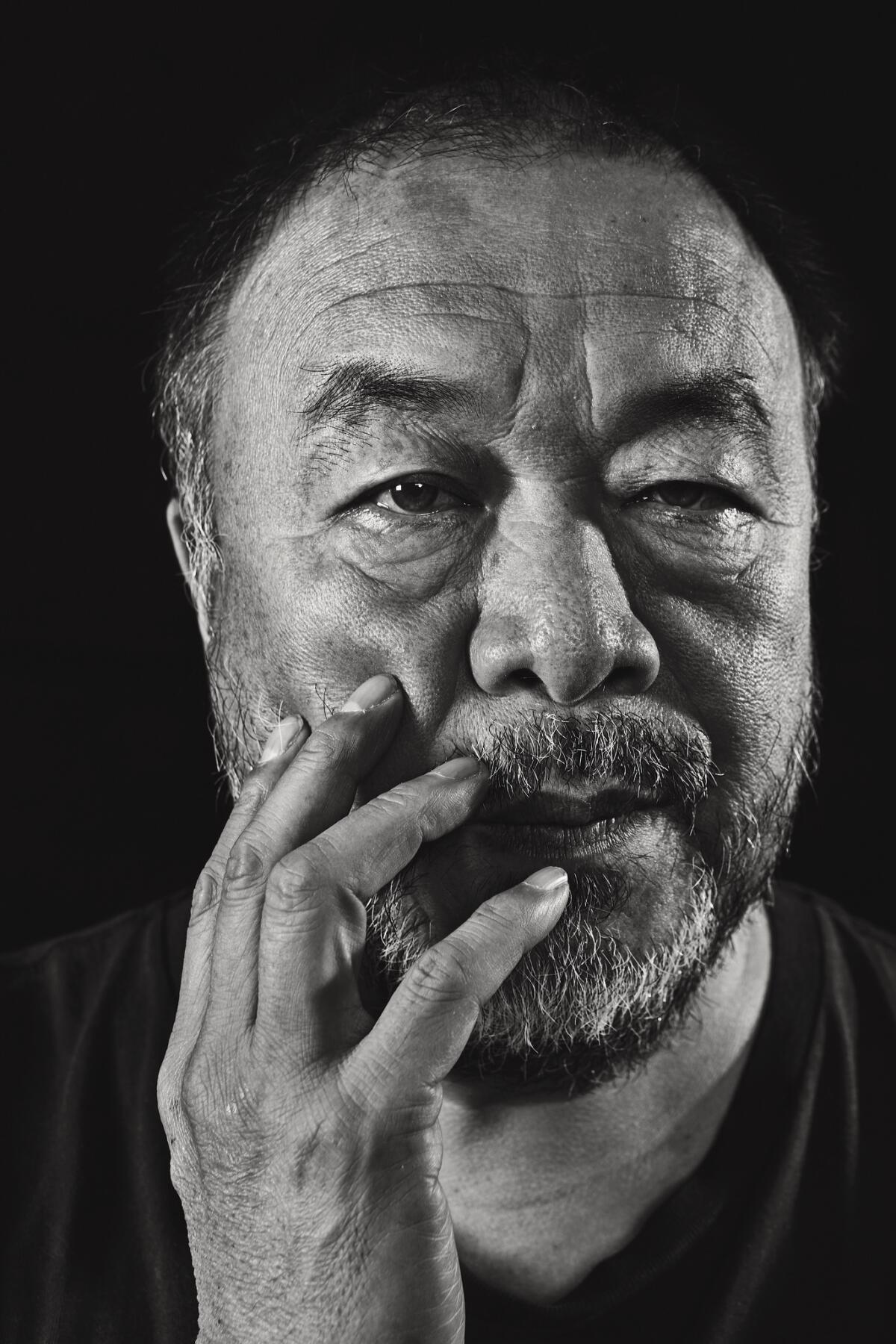
âIâm completely lost,â Ai admits about his presence in Los Angeles, then apologizes if he doesnât âfunction that wellâ because he was âtotally blacked out for two daysâ before our meeting. In addition to visiting a few casinos in the Greater L.A. area, Ai took a temporary break from the reality of his daunting work scheduleâover the past few years heâs traveled to 40 refugee camps in 23 countries to bear witness to the global refugee crisis for his epic Oscar-shortlisted documentary Human Flow; placed 100 border-fence sculptures throughout the five-boroughs of New York City for a massive public art installation called Good Fences Makes Good Neighbors; and prepared for his first solo exhibitions in Los Angeles at the Marciano foundation, the debut of the 15,000-square-foot gallery of former MOCA director Jeffrey Deitch, and the new UTA Artist Space in Beverly Hills, which Ai designedâto indulge in a decidedly Angeleno experience: frequenting a weed dispensary.
âWe were eating at a Korean restaurant and it was right around the corner,â recalls Ai, with a laugh. âMy friend found it on Google Maps. It was funny. This shop with no windows. There was this guy pretending to be a cop. I was like, âWow, everything is here.â So many products, so much candy and soft drinks. So I got some of them, but it was so strong. I have no culture of that. Hopefully this interview is still right.â
Like some kind of perpetual-motion dignitary, traveling with (and into) the closest facsimile to a White House press pool in the international art world, Ai has no choice but to be right, or at least present. His schedule insists that he is always in the moment, whatever that moment might bring. Oftentimes it's just people stopping him on the street, be they collectors, fans, well-wishers or just curious citizens wondering: Who is this energetic bulldog of a man constantly taking selfies?
Waiting for Ai after this sit-down are a handful of photographers from various print publications. Theyâre lighting vignettes for drive-by portrait sessionsâAi, with a publicist minder constantly watching the clock, will spend about 15 minutes posing for each cameraâon the mezzanine and in the lobby while a CNN camera crew shoots B-roll in the foundationâs main hall Theater Gallery. There Ai and a team of assistants have installed three epic sculptural installations: Sunflower Seeds (2010), Spouts (2015) and Life Cycle (2018), which are respectively comprised of 50 million hand-painted porcelain husks (or half of his jaw-dropping 2010 Turbine Hall installation at the Tate Modern in London) made by 1,600 artisans in Jingdezhen; thousands of teapot spouts dating back to the Song dynasty; and the last piece shipped from his Beijing studio before the Chinese government bulldozed it in Augustâa stunning reproduction, sort of an analog hologram that dematerializes before your eyes, of a PVC sculpture depicting refugees on a lifeboat.
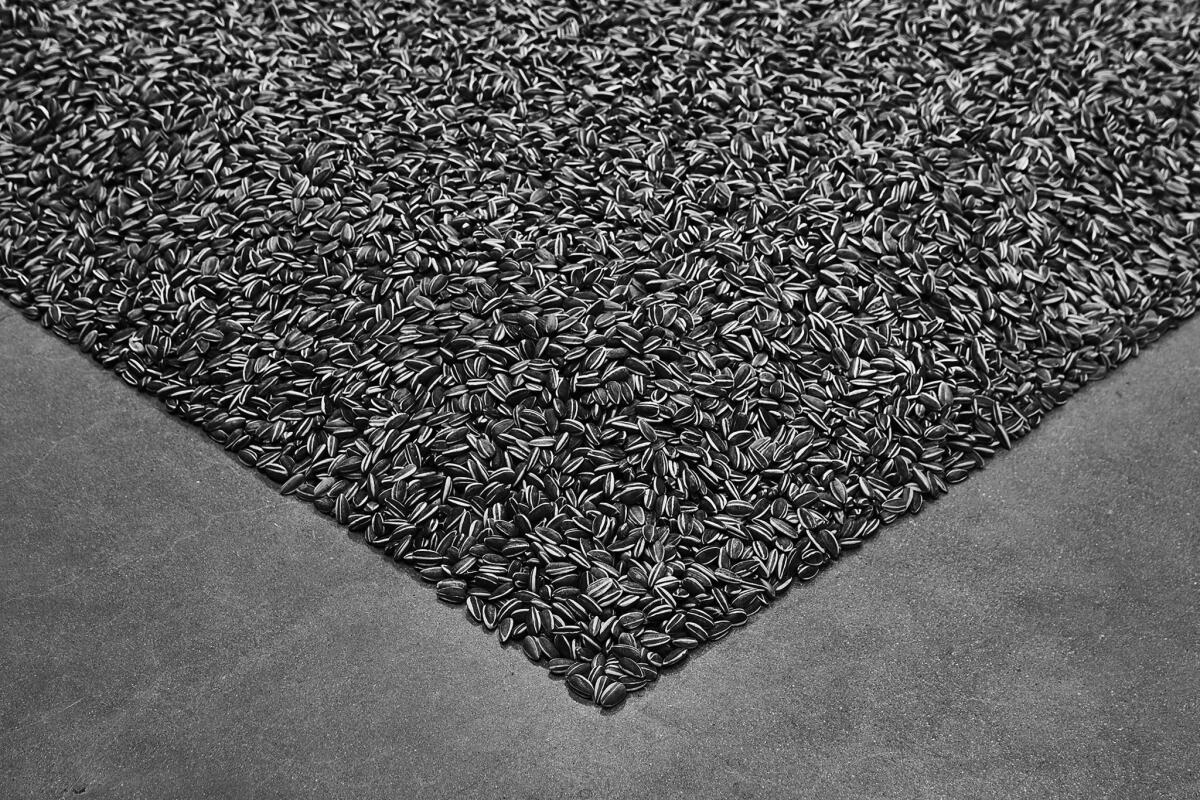
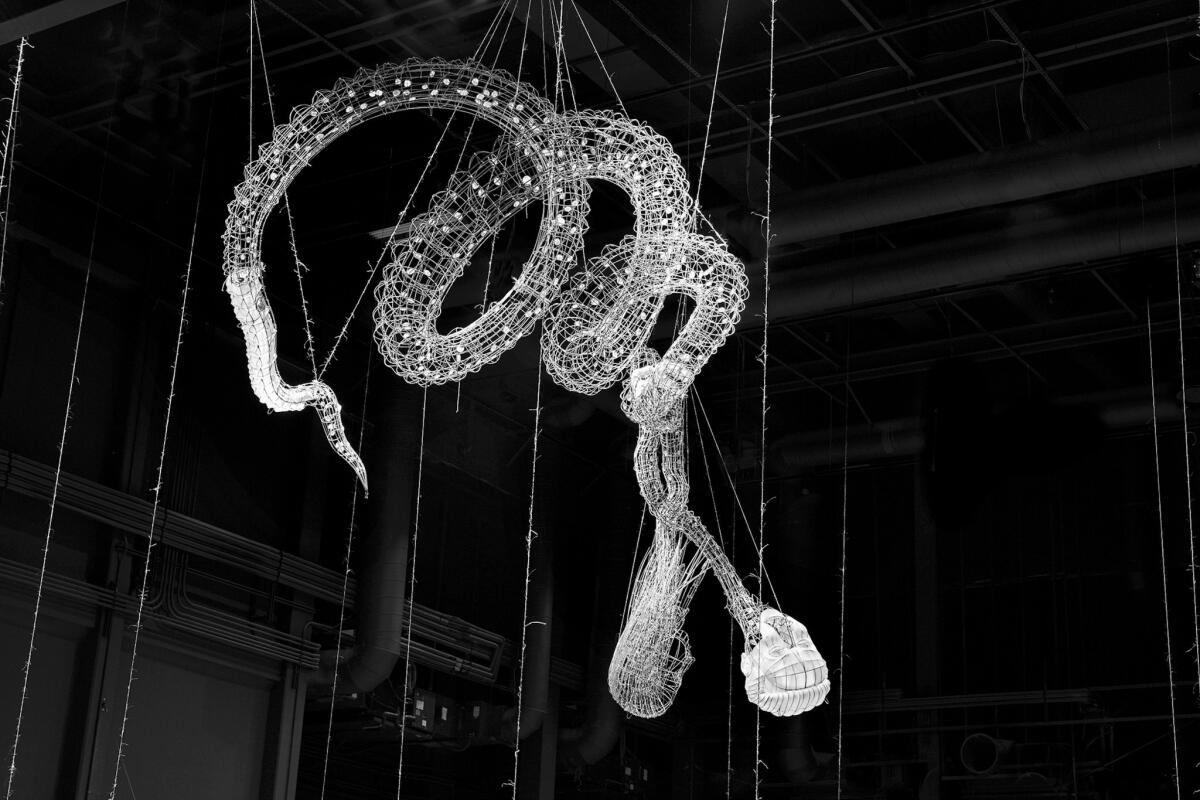
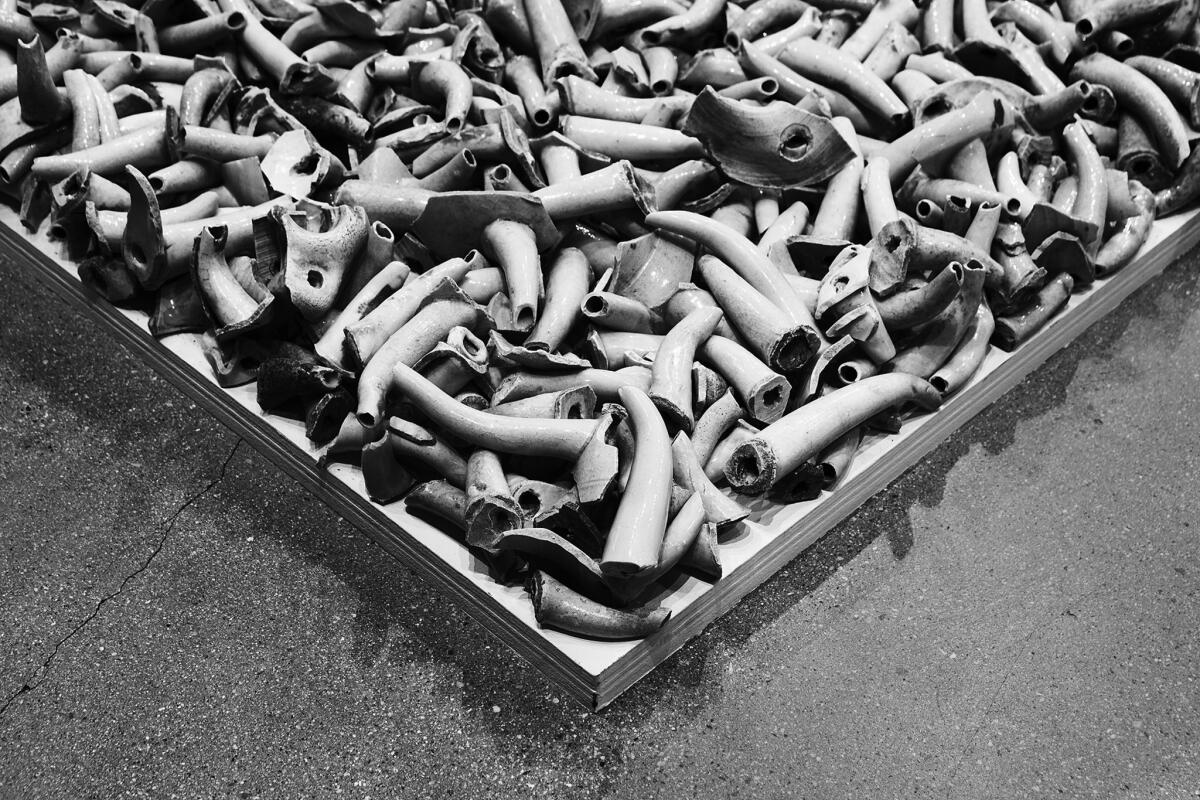
Hewn from bamboo and silk by Shandong province kite-makers, who employ a craft alive since the 14th century, Life Cycle recreates a refugee lifeboat surrounded by various deities, middle-finger gestures and references to Aiâs art-history icons like Duchampâs final work, Ătant donnĂŠs, floating above or casting shadows against the walls. The addition of refugee quotes from Homer to Zadie Smith prompted Times critic Christopher Knight to write: âThe work feels, if not exasperated, certainly argumentative. The quotations are like academic footnotes, as if such are needed. For all its heartfelt compassion, the sculpture doesnât carry the quiet, stately power of Sunflower Seeds and Spouts.â Still, taken in total, itâs a knockout effect that is further magnified by the Deitch effort.
âI think Ai Weiwei is thinking about what is nextâheâs looking at cities, heâs looking at people, and I think one of the thing heâs looking at is the diversity of people,â says Michael Govan, director of the Los Angeles County Museum of Art, where Ai unveiled The Zodiac Project, his first public artwork featuring twelve bronzes of animal heads representing the Chinese Zodiac symbols, which date back to 1750 and once adorned the fountain at the Old Summer Palace in Beijing until a century later, when Anglo-French troops looted them during the Second Opium War. LACMA first exhibited the piece in 2011, but Ai couldn't make that show, as he was under what would become a heavily surveilled four-year house arrest following an 81-day detention by Chinese authorities, who had just bulldozed his Shanghai studio.
âLos Angeles is a target in Aiâs mind because itâs a big, diverse, crazy city and he didnât get to see it when we showed his work here,â adds Govan. âSo this is a great intervention. I think it shows his interest in the diversity of Los Angeles, and Los Angeles has been receiving him really well. What I like about him is that heâs got that unsuspected ambition. Heâs quiet, kind of funny, but thereâs huge ambition, and that feels a little like this place.â
âLos Angeles is a target in Aiâs mind because itâs a big, diverse, crazy city and he didnât get to see it when we showed his work here.â
â Michael Govan
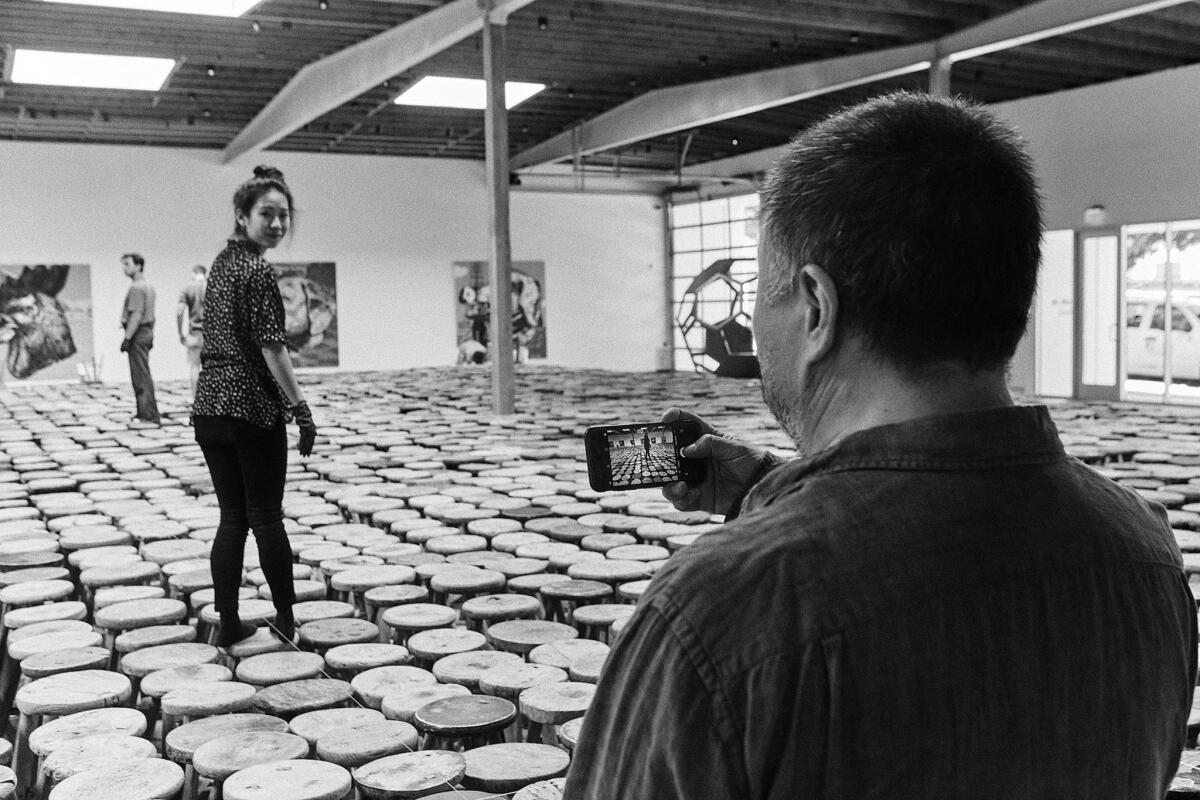
With a second studio demolished, Ai was actually looking at properties in L.A. for months until a collector friend located a space for him in upstate New York. âThere are very strong characters in Los Angeles, but we couldnât find a location that I could use as both a residence and a studio,â explains Ai, who also maintains a live-work studio inside a former East Berlin brewery. âYou either find a place too wild or a place with no living conditions but nice studio space. Iâm very familiar with New York. I donât want to go to the city, but outside the city itâs okay.â
In some respects, this move stateside represents a through-the-looking-glass moment for Ai Weiwei. He studied at the Parsons School of Design and lived in the East Village from late eighties to the late nineties. Lower Manhattan was where Ai wet his toes in the contemporary art world and met icons like Andy Warhol and Allen Ginsberg. But a lot has happened in the past three decades.
âI had one small show in a small gallery in New York in 1987,â says Ai. âAfter that I gave up. I said itâs not possible for me to survive in this kind of art world.â He eventually went back to China, where he began making books and curating shows. He launched his architecture practice, FAKE Design, while studying antiquity and making a name for himself with political rants, musings on art and architecture, and investigations into humanitarian crises like the 2008 Sichuan earthquake on a blog that ran from 2006 until 2009. But after Ai covered the façade of the Hitler-commissioned Germanic art museum Haus der Kunst with 9,000 primary-colored backpacks spelling out a letter from a mother who lost a child in the quake (it read simply: âAll I want is to let the world remember she had been living happily for seven yearsâ), Chinese authorities pulled the plug on Aiâs blog, the platform for the Sichuan Earthquake Names Project, which had thus far uncovered more than 5,000 of the victimsâ names. âI never thought I would become an artist again. To me, to have that kind of profession is beyond anything I would never think.â
âItâs like youâre a boxer and you only fight for two rounds. I want to be beaten, I want to see the spew of the blood, otherwise I donât feel that much.â
â Ai Weiwei
But again, a lot can happen in 30 years. In the past decade alone Ai designed the Birdâs Nest stadium (with Herzog & de Meuron) for the 2008 Olympics and the 2012 Serpentine Pavilion; conceived major exhibitions for the Royal Academy in London and Washington D.C.âs Hirshhorn Museum and Sculpture Garden; and had his studio hand-straighten 150 tons of steel rebar recovered from the Sichuan earthquake for a mountainous installation, Straight, at the 2013 Venice Biennale. He even made three music videos, including Dumbass, which spoofed his 81-day detention at the hands of Chinese authorities after his investigations into the doctored death tolls from the earthquake. Given all heâs seen in the past six decadesâAi actually lived his early adolescent years with his family in a dugout trench after his father, the modernist Chinese poet Ai Qing, was accused of being a ârightistâ and forced to clean public toilets in the hinterlands during the late 1950sâitâs amazing he manages to cope with it all on a single-dosed candy and a few rounds of blackjack.
âHeâs not constrained by those inside art-world issues the way some other artists are,â says Jeffrey Deitch, admitting that his gallery basically ran a 24-hour opening (with 36 valets on hand) to accommodate the Weiwei wave with some degree of civility. âHeâs not strategic. Itâs basically if people are embracing him, heâll respond, and here heâs responded to the three spaces that were proposed to him. There were many major artists at our opening and the Marciano opening. They know this is something important.â
In fact, Aiâs import is such that countless Angeleno art stars and Hollywood heavyweights didnât just linger for hours at his trifecta of openings, they literally lined up to take selfies with him and read his quotes on Crisis (History teaches us that at the beginning of the greatest tragedies was ignorance), Borders (I hate fences, any kind of fence. It stops people, it separates people, and it makes so many lives difficult), Power (I have no illusions about power, where there is power there is danger), Displacement (Only in the most extreme conditions do you see how broken this world is) and Freedom (Freedom is not an absolute condition but a result of resistance) from his little blue book Humanity for an aggregating video piece at the UTA space.
âThe critical mass of art and advanced culture is really here with artists, curators, gallerists, museums, the Frieze art fair coming,â adds Deitch. âAnd for one of the great artists of the world to be here and doing something on this level of ambition, this is very exciting for Los Angeles.â Deitch immediately thought to open his massive Frank Gehry-designed space in Hollywoodâformerly a warehouse for film lighting equipmentâwith Ai because he knew he could âhandle a space of this scaleâ with iconic works like five minimalist cubes (including one made from a ton of compressed Puâer tea, another of two tons of cast crystal, and another of three tons of marble); Stools, a vast sculptural landscapeâor pointillist sea of humanityâcomprised of nearly 6,000 hand-joined stools collected by the artist dating back to the Ming dynasty; and a dozen âpaintingsâ made from thousands of Legos that feature the twelve symbols of the Chinese zodiac (a work that references and merges The Zodiac Project and Aiâs eight-year-long Study of Perspective photo series of power structures like the White House, Eiffel Tower and Tiananmen Square interrupted by the artistâs raised middle finger).
âI think heâs showing this ambitious way for presenting your work as an artist and just taking on the town,â says Deitch. âAnd I hope it will be inspiring to other artists to think big, go all the way.â
For Ai Weiwei there are no half-measures, and if that throws down a gauntlet for other artists on their home turf, so be it. âToday, if I count, I have over one hundred solo exhibitions, which could be higher than anybody, and over four hundred group shows, but not one of them did we initiateâ says Ai. âItâs always been through friends.â He was slightly cynical about the prospects of showing in Los Angeles until Deitch, who has known the artist for more than 15 years, made him an offer. (In 2016, at his SoHo gallery, Deitch exhibited Weiweiâs Laundromat installation, featuring the laundered, and once buried, clothes and thousands of photos of Syrian refugees.) âHere, we wanted to have one spectacular work taking advantage of the dimensions of the space where people would come in and be amazed,â says Deitch.
Amazing in a lone museum-sized gallery space, however, is just not that amazing to Ai. âOnce I show in a place, one location seems like itâs not enough,â says the artist without a hint of braggadocio. âItâs like youâre a boxer and you only fight for two rounds. I want to be beaten, I want to see the spew of the blood, otherwise I donât feel that much. Itâs basically very selfish.â
Where other artists of Aiâs stature might be tempted to take it easy in his positionâbuy houses, cars, collect art, open a private museumâheâs not happy until heâs mentally and physically exhausted from work. Exhausted is a word he uses with frequency and seems to equate with some sense of liberation. The last time we spoke he couldnât say enough about his first âvacationâ with his family to the Greek island of Lesbos, a location chosen so he could get a firsthand look at the refugee crisis. That fateful trip inspired Human Flow.
The week he arrived in L.A., CNN was reporting that 130 children detained at the southern border of the United States might never be reunited with their families. Still, Ai was optimistic. âI think the situation is pretty dark, but of course there is always light, and when itâs darker the light should be brighter,â he says. âWeâve lost control to politicians, to this diplomatic movement bringing more hatred, becoming more narrow-minded. So since the liberals are not really liberal, theyâre just losing ground in defending the very basic values, and thatâs a problem that will continueâweâre just one step deeper in the shithole. But certainly we realize the situation now.â
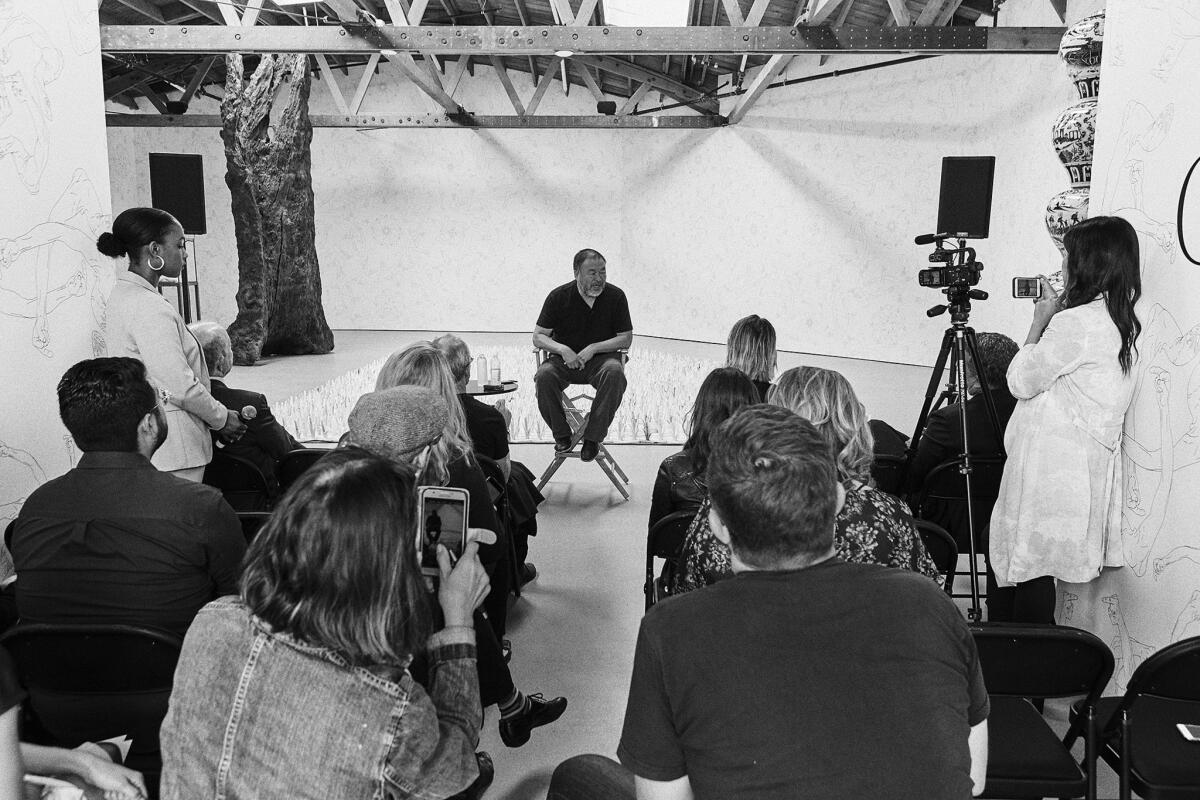
In other words, in the Trump era itâs easy for the theater of the absurd to seem like everyday fare. Case in point, as Ai walked onstage for his LACMA talk, the standing-room-only crowd (including Frank Gehry, Will Ferrell and 125 overflow attendees who watched on a movie screen in an auxiliary space below the Bing Theater) laughed at the Dumbass video playing on the video screen in the background. While it is slightly satirical, and while Ai cracks a number of jokes throughout his talk with Michael Govanâribbing Gehry that his design for Deitch wasnât like any of his other buildings, and for that reason he really liked itâit becomes easy to forget that two years prior to his detention, Ai was beaten so badly in a hotel room by police as he was about to testify on behalf of a fellow earthquake researcher that he received emergency surgery for a brain hemorrhage at a Munich hospital just before his Haus der Kunst opening.
âHe has celebrity status in a very different way,â says Govan. âItâs not from being in movies, itâs from being in prison and surviving and being tough and speaking his mind and having a moral compass and all those other things. Thatâs the cool way to be a celebrity.â
But what does being a celebrityâor having other celebrities like Ferrell, who read from Humanity (âHumans do not rule the universe, we are temporary passengersâ) wearing a rainbow-striped blazer outside the VIP party in LACMAâs Pavilion for Japanese Art before the talk at the Bingâreally mean when Ai informs me that there are now 68.5 million displaced people in the world, up from 65 million since we spoke last fall.
âArt is always above the reality, but it cannot be detached. It always relates to humansâ deepest sorrow, otherwise there is no literature, art and poetry.â
â Ai Weiwei
âWeâre in a deep struggle,â says Ai. âArt is always above the reality, but it cannot be detached. It always relates to humansâ deepest sorrow, otherwise there is no literature, art and poetry.â Take the numerous bamboo and silk renderings of the deities and mythic creatures from the Shanhaijing, or Classic of Mountains and Seas, which Ai installed above and around the refugee raft in the Life Cycle installation at the Marciano. On one hand the Classic is Chinaâs ur-geo-cultural text, with vivid mythologies of hundreds of geographical landmarks and fantastical creatures. On the other hand, depending on how you view such a heavily edited source material in this hyper-partisan moment, you might also see the Classic (and Aiâs translations of it) as somewhere between the Bible and âfake news.â
âYes, itâs good you put these two words together: Bible and fake news,â Ai notes. âYou have to have humor to look at things like that. One hundred years from now they will look at us to see how ridiculous circumstances can happen, like that time nations would have nuclear bombs to destroy the whole universe one hundred times over. What is the intention? How are they going to use it? Why donât they give it up? These are questions everyone should ask themselves when they wake up, when they put their children to bed, even just for a moment. Why are those nuclear bombs being held by the United States, China and Russia? Itâs a really ugly game. Weâve given up the fundamental beliefs of how these nations were founded: human rights, everyone created equal. If those things are still an argument, it means we are not that far from a barbarian society, weâre still quite bloody and primitive in our politics.â
The day before he left town, Ai opened his third and final show, Cao/Humanity, at the UTA Artist Space. Like all three shows, this exhibition was dedicated to the memory of Joshua Roth, the head of UTA Fine Arts, a hybrid division of the talent agency that has hosted exhibitions for Larry Clark, the Haas Brothers and Derrick Adams at its previous gallery in Boyle Heights. After Roth showed Ai the Beverly Hills space during his L.A. press tour for Human Flow, he quickly agreed to do the redesign.
âOnce I see a person, normally I have a sense that we have something that belongs to each other,â says Ai. âWe share an idea to innovate, something that breaks the borders with this so-called art circle.â He received the news of Rothâs deathâhe passed in New York at age 40, three weeks before the UTA openingâon his phone. âDeath is a void. It doesnât matter how you feel, itâs total emptiness. I have several very close associate friends who passed away, and I kind of feel that maybe thatâs something to do with me.â He pauses between thoughts. âI start to feel strangely. We were so close, and then suddenly they just disappeared. So whoâs next? It gave me a sense of urgency to see life is ephemeralâitâs very short, unpredictable.â
In the face of that unpredictability, that fragility, Ai once again raised his middle fingerâfor the iPhones of hundreds of fans (some famous, most not) on the street outside the UTA opening, and inside through a cast-glass sculpture of an arm from shoulder to extended digit; on custom wallpaper printed with spiraling vortexes of flipped birds; and in a small patch of âgrassâ pieced together with hexagonal marble tiles sprouting blades that embody the other meaning of this titular work, Caoâat the establishment for the displaced, the discarded and the deceased.
An hour and a half before last call at the UTA opening, Ai Weiwei leaves his final party in L.A.âat least for nowâso he can hop an early flight to SĂŁo Paulo, for his biggest solo show to date. Itâs somehow fitting that this city-wide assault transpires during Brazilâs presidential race, in a time when the leading candidate is a far-right nationalist in the mold of Trump, who famously called refugees âthe scum of the earth.â If that werenât ironic enough, the day after Ai leaves L.A., Brett Kavanaugh was confirmed to the United States Supreme Court, which likely wonât be a boon to the refugee crisis either. Nor will the State Departmentâs reduction in refugees admitted into this country. (Next year it will be 30,000; the U.S. admitted more than 200,000 the year congress passed the Refugee Act in 1980.)
So the question remains: Why, after all this, does Ai keep going ... and going ... and going? Even when he tells me heâs âquite exhaustedâ from it all? To get some better understanding, I read from Action, the final chapter in Humanity, Aiâs call to arms for every citizen from every nation ignoring the countless humanitarian crises around the world while wrapped inside the comfort of our smartphones and dumbed-down politics.
âI donât need anything,â Ai explains of himself. âI just want to burn myself out. Itâs lifeâyou better use it.â As for the rest of us? âIf you can, you have to help.â
